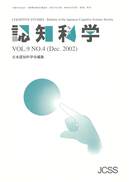Volume 9, Issue 4
Displaying 1-11 of 11 articles from this issue
- |<
- <
- 1
- >
- >|
Foreword
-
2002 Volume 9 Issue 4 Pages 471-472
Published: December 01, 2002
Released on J-STAGE: October 03, 2008
Download PDF (104K)
Review Paper
-
2002 Volume 9 Issue 4 Pages 473-486
Published: December 01, 2002
Released on J-STAGE: October 03, 2008
Download PDF (2127K)
Research Papers
-
2002 Volume 9 Issue 4 Pages 487-500
Published: December 01, 2002
Released on J-STAGE: October 03, 2008
Download PDF (3903K) -
2002 Volume 9 Issue 4 Pages 501-515
Published: December 01, 2002
Released on J-STAGE: October 03, 2008
Download PDF (4307K) -
2002 Volume 9 Issue 4 Pages 516-531
Published: December 01, 2002
Released on J-STAGE: October 03, 2008
Download PDF (3080K) -
2002 Volume 9 Issue 4 Pages 532-542
Published: December 01, 2002
Released on J-STAGE: October 03, 2008
Download PDF (2020K) -
2002 Volume 9 Issue 4 Pages 543-563
Published: December 01, 2002
Released on J-STAGE: October 03, 2008
Download PDF (2417K)
Tutorial
-
2002 Volume 9 Issue 4 Pages 565-579
Published: December 01, 2002
Released on J-STAGE: October 03, 2008
Download PDF (5525K)
Debate
-
2002 Volume 9 Issue 4 Pages 580-585
Published: December 01, 2002
Released on J-STAGE: October 03, 2008
Download PDF (920K) -
2002 Volume 9 Issue 4 Pages 586-591
Published: December 01, 2002
Released on J-STAGE: October 03, 2008
Download PDF (1185K)
Book Review
-
2002 Volume 9 Issue 4 Pages 592-594
Published: December 01, 2002
Released on J-STAGE: October 03, 2008
Download PDF (316K)
- |<
- <
- 1
- >
- >|
